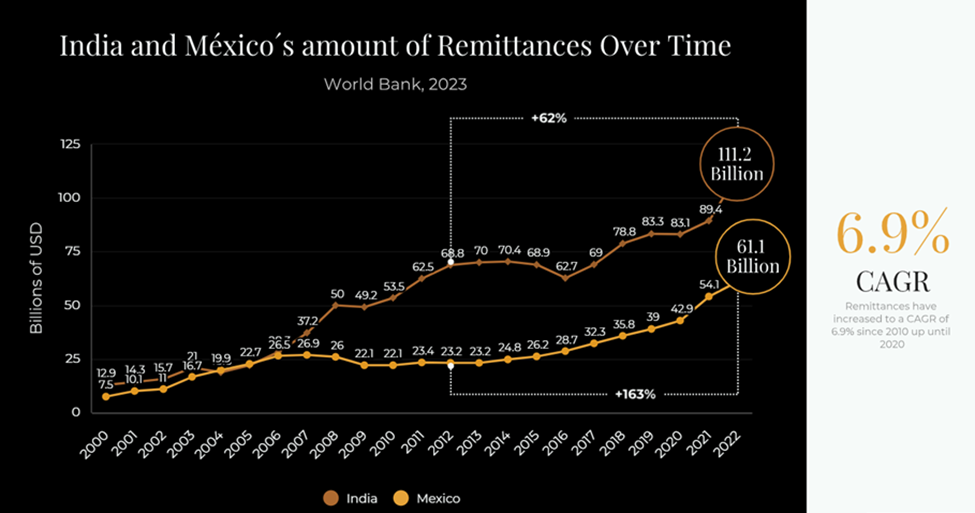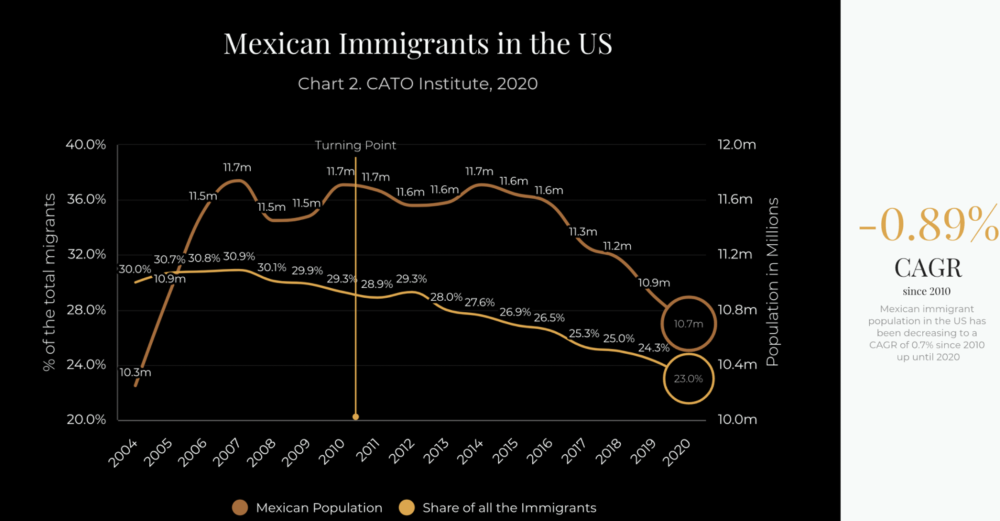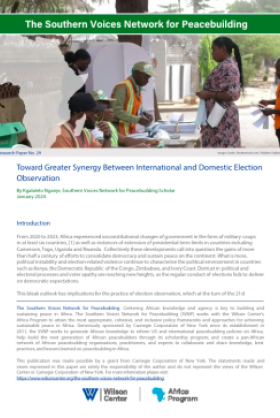Migration and Remittances through the Electoral Lens

Amid the 2024 presidential election process in Mexico, all three candidates released their national project proposals explaining the key agenda items that their government would prioritize. Topics range from economics, justice, and infrastructure to education, healthcare, and security. However, a critical factor often overlooked is the volume of remittances received by Mexico annually. Previous administrations have recognized the contribution of remittances to the economy and maintained a record of them, but there has been little effort to understand the dependence of low-income Mexican families on remittances, the potential consequences of changes in remittance inflows; let alone a plan to shift away from remittances dependency for economic development. This review seeks to highlight the impact of remittances on Mexican economic development; I review the proposals of each presidential candidate and evaluate to find if they have a plan to address them and if so, how would it impact Mexico’s outlook in the years to come; and finally, I will recommend a policy plan for the next administration to consider.
According to Banco de Mexico, in 2024, the amount of remittances received was a record $63,313 million USD, almost three times the amount recorded in 2013. With a compounded annual growth rate (CAGR) of 11% from 2013 to 2023 remittances have become increasingly essential to Mexico's economic dynamism. To evaluate their importance, it is useful to compare the volume of remittances to Mexico's GDP over time. Since 2013 remittances have grown from 2% to represent nearly 4.2% of the GDP in 2023.
This significant increase has not gone unnoticed by past administrations. President López Obrador (AMLO) has been positively vocal on remittances stating they were one of the main ingredients for growth both in 2022 and 2023. If we were to compare Mexico's GDP growth over the last decade we could see why remittances are so important. Just last year Mexico's GDP grew 3.1% or approximately $46 billion USD; nearly $17 billion USD short compared to the volume of remittances of $63 billion USD recorded over 2023.

David Juarez Davila
It is no surprise that AMLO hails remittances as a key ingredient of economic growth every year. However, in practice, remittances require little to no lift by the government. At the same time, it is difficult, if not impossible to influence their drivers, especially considering the shift in demographics and volumes that Mexican migration has undergone over the last two decades.

DAVID JUÁREZ DAVILA
From 2010 to 2020 Mexican migrants in the US decreased at a yearly CAGR of -1%. Still, remittances grew over this period at an 8% CAGR through mixed factors including a shift in the Mexican migrant demographics, which entailed more educated Mexican migrants, second-generation Mexican migrants with better jobs, fewer unauthorized Mexican migrants, more work permits, and money laundering from cartels entering more heavily into the equation.
Whether one demographic factor has contributed more than others remains unclear. Nonetheless, the importance of remittances to the Mexican economy is evident.
Despite remittances’ economic impact, no policy other than Mexico’s Central Bank quarterly record and its continuous efforts to safeguard remittances’ transfers transparency to avoid money laundering from illegal activities, has been put in place. The reason is there is little to no room for control over remittance drivers (migrants, migrant’s income, and migrant’s propensity to remit). However, this has not deterred the last administration from recognizing them as one of the main sources of income for low-income families in Mexico reaching as many as 4.9 million households and nearly 11 million adults in 2022. According to research done by the Interamerican Development Bank (IDB), remittances alone were responsible for lifting 2.2 million Mexicans out of poverty in 2022. Another IDB study mentioned how Mexican remittances were “most often sent to their parents (40%), and mostly for regular household consumption (66%) including food, rent, utilities, etc.” Not only that, this study pointed out that “if parents rely on remittances as a steady source of consumption income, there is little scope to let them down,” highlighting the over-reliance of underprivileged Mexican families on remittances rather than on a comprehensive federal economic development strategy that addresses poverty issues from its roots by leveraging remittances as a complement of such policy instead of using it as the main tool to uplift marginalized Mexican communities.
For the incoming administration, the danger of taking remittances for granted is twofold. First, low-income households’ dependency on remittances to survive, rather than improving welfare through sustainable and inclusive domestic economic growth, masks underlying inefficiencies in Mexico’s approach to poverty and inequality. Secondly, continuous changes in Mexican migrant demographics and behaviors could lead to a decline in remittances, dealing a significant blow to the economy. These two aspects, combined with ever-changing migration dynamics and a limited federal budget, make it crucial to examine the proposals of the presidential candidates to transform the economic over-dependence on remittances into a sustainable resource aligned with current economic development policies.
For the incoming administration, the danger of taking remittances for granted is twofold. First, low-income households’ dependency on remittances to survive rather than improving welfare through domestic sustainable and inclusive economic growth masks underlying inefficiencies in Mexico’s approach to addressing poverty and inequality. Secondly, continuous changes in Mexican migrant demographics and behaviors in the coming years could cause a negative shift in remittances which would deal a significant blow to the economy.
Secondly, continuous changes in Mexican migrant demographics and behaviors could lead to a decline in remittances, dealing a significant blow to the Mexican economy – especially to those who depend on remittances.
These two aspects, combined with ever-changing migration dynamics and a limited federal budget for welfare programs, make it crucial to examine the proposals of the presidential candidates to transform the current remittance over-dependence panorama into a comprehensive sustainable strategy that uses remittances as a resource that aligns with future economic development policies rather than over-relying on them to improve marginalized communities' welfare.
Beginning with the Morena candidate, Claudia Sheinbaum and her “100 steps for transformation.” This plan addresses both migration and remittances from the following strategic angles:
1. Social development with a regional perspective. Sheinbaum’s plan emphasizes the continuation of economic growth within strategic regional areas through leveraging nearshoring momentum and “infrastructure projects that trigger more inclusive and fair economic development.” This aims to reduce inequality between different geographic areas of the country by encouraging employers to move closer to where people seeking jobs live, reducing migration for employment.
While convincing companies interested in nearshoring to move to “strategic regions” in Mexico is difficult to promise, we have seen Morena engage in large infrastructure projects in the south; whether they are efficient or useful is a different story.
2. Foreign policy.
A. Migration. The plan highlights a “shift in migration management, focused on the development of communities of origin” during AMLO’s term and then proposes to address migration through the “institutionalization of regional mobility” by focusing on the creation of a permanent mechanism to coordinate efforts in human mobility management that addresses the fundamental causes of migration of both domestic and in-transit migrants. Following up on this point would be important as the creation of a regional agency to coordinate efforts and policies is much needed to effectively address migration from and through Mexico.
B. Mexicans abroad. AMLO’s administration introduced the “Finabien” debit card that facilitates affordable remittance sending. The incoming plan is to expand the reach of this service. It also includes a point on “facilitating Mexican housing purchase” which has no more details, but it would be important to further elaborate as remittances received tend to be diverted in many directions once sent. However, directing them to buy assets that generate sustained generational welfare could be a way to address migration from its roots. It also mentions that their plan for return migrants is to foster entrepreneurship and stimulate financial inclusion in return communities. Finally, it touches on the strengthening of the bilateral relation with the US by expanding legal paths for work opportunities abroad and establishing direct connections between employers and workers to “foster orderly and secure migration.”
The proposals of the PRI-PAN-PRD coalition's candidate, Xóchitl Gálvez, include specific actions in the following “pillars”:
1. Housing and mobility
114. “Allow the remittances received to be linked to the payment of mortgages so that they become equity investments.” Somewhat like Sheinbaum’s proposal but a bit more specific in its application. This strategy would allow migrants to generate capital wealth while increasing welfare and reducing incentives to migrate for future generations in returning communities.
2. Tourism
103. Leveraging tourism through further expansion of the “Pueblos Mágicos” initiative to impulse economic development that addresses poverty, migration, and family disintegration. This initiative has proven to be one of the most effective in activating small-town economies from both domestic and foreign visits. A continuation of the program might also help reduce low-income families’ incentive to migrate.
3. Agriculture:
80. Provide more VISA permits for agricultural labor to legally work seasonally in the US. Having a plan for the continuation of legal worker permits is crucial for households to continue applying through the proper channels of migration as well as having certainty of the influx of remittances from a baseline of legal workers sent every year.
4. Foreign Policy
360. “Articulate a strategy to potentialize nearshoring to attract foreign investment.” Galvez has been very vocal about this point in her campaign. During her latest visit to D.C. she mentioned part of her plan to attract nearshoring was to directly connect the industry labor force demand to the supply by capacitating Mexican labor in key areas such as engineering, electronics, and ITC. She mentioned she met with several industry leaders to understand their needs and generate a cohesive plan to optimize this momentum. In materializing this, the following administration could potentially move households away from their dependency on remittances by substituting remittance income with foreign employers moving in instead of employees moving out.
Finally, candidate Jorge Ávarez Máynez from Movimiento Ciudadano does not address remittances directly in his brief document of proposals; however, he does talk about promoting international collaboration for student and Professor exchanges and generating partnerships with the private sector, so students have a smooth transition into the labor force after graduating. These policies could address job seeking as a main driver of migration. He also mentions redesigning immigration policy so that migration is orderly, safe, and regular. Neither idea offers a different approach from the other candidates; they are only mentioned as general objectives.
Overall, both Galvez and Sheinbaum’s proposals intersect in terms of migration and remittance management addressing some of migration’s fundamental causes. Both aim to increase the legal pathways for temporary work permits and create means for Mexicans abroad to send money and build real estate assets in Mexico. However, Galvez’s focus has been on the use of nearshoring and human capital development to match incoming labor market demands while Sheinbaum’s tactics involve more government intervention to promote economic growth through the continuation of federal investment in projects in key regional areas in the south. Both acknowledge a need to increase working visa permits, however neither focused on skilled workers which could be an area of opportunity if the conditions for competitive salaries curb brain drain.
Furthermore, all three candidates coincided with the need for a new cohesive policy designed and followed by all agents involved to effectively address migration challenges. This point will be worth tracking, as currently Mexico and the US seem to lack a coordinated approach. As shown by US Homeland Security’s latest announcement on “Imposing Stiffer Consequences for Failing to Use Lawful Pathways” coupled with its increasingly restrictive measures to deter migration influx over the last couple of years. This contrasts with Mexico's policy to “humanize migration” by providing legal pathways for migrants to continue their journey in an orderly and secure fashion as stated by Alicia Bárcena, Mexico's Secretary of Foreign Relations, at the UN’s 78th General Assembly. These differences continue to pile up, particularly as new radical initiatives are considered in the US like the recent Texas SB4 immigration law which Mexico´s Foreign Relations Secretary recognized as invalid.
Though some work has been done from the Mexican side to slow migration influx, new policies are mildly applied and, as noted by Maureen Meyer, “there’s a lot of movement of people in the Mexican border but there´s not a clear idea of what is happening.”
Understandably, both countries have different incentives and consequently different policies to approach migration. However, a comprehensive reform that aligns both interests in one direction could render better results than half efforts do.
Looking forward to the Mexican elections, both leading candidates have key compromises that indirectly address remittances influx by approaching migration's fundamental causes as well as marginalized Mexican groups’ overdependency of remittances mainly through job creation from both domestic and foreign sources. The question will be if elected, will they be able to achieve those proposals, and how. There are evident strengths and weaknesses in both strategies. From the Morena side, federal interventions by spending on large projects tend to suffer from a lack of transparency, profitability, and efficiency. However, they have had victories bringing economic dynamism to Mexico’s southern region. On the other hand, the opposition party “Coalición Fuerza y Corazón” is known for aligning its interests to those of the private initiative and international markets. However, proposing to bring foreign companies to Mexico is one thing, and making it happen is quite another. Meeting all the conditions demanded by foreign companies (qualified labor, resources, low entry barriers, soft-landing programs, etc.) is challenging14 and even if all the conditions are met, there is no guarantee the terms will benefit local communities as much as foreign companies when negotiating resources15, salaries, or even entrepreneurial efforts or if as usual the will be mostly captured by developed areas or distributed to low-income communities.
Regardless of these important differences in each party´s strategy, one thing is clear. Remittances are a crucial economic driver, especially for low-income Mexicans, whose welfare impact reached over 4.9 million low-income households and nearly 11 million adults in 2022. Unsurprisingly, the nature of their dynamic drivers as well as the recent shifts in Mexican migrant’s demographic make remittances difficult to predict, next to impossible to control, and hence very unwise to rely on for sustained economic development.
Moreover, recent trends in Mexican migration deceleration combined with the latest growth reduction in remittances received in the first quarter of 2024 (-3.3% YoY) should serve as a warning for future government officials about possible decreasing remittance trends ahead and the latent danger of relying on remittances for economic development. Therefore, the next administration should bring a comprehensive plan that integrates policies that shift away from remittances overdependency to aid low-income communities to a sustainable economic development framework that integrates policies that tackle poverty and migration issues from its roots; considering remittances as an alternative buffer instead of a main strategy to rely on for economic development of low-income Mexican households.
About the Author


Mexico Institute
The Mexico Institute seeks to improve understanding, communication, and cooperation between Mexico and the United States by promoting original research, encouraging public discussion, and proposing policy options for enhancing the bilateral relationship. A binational Advisory Board, chaired by Luis Téllez and Earl Anthony Wayne, oversees the work of the Mexico Institute. Read more













